 センター概要
センター概要
内分泌腫瘍治療センターは各分野の専門医を含む医師が一体となり、
内分泌臓器を対象に診断から治療まで最善の医療を提供します。
当センターは近年増加する患者さんの医療ニーズを充足するため、当院所属の内分泌学会専門医・甲状腺学会専門医・脳神経外科学会専門医・耳鼻咽喉科頭頸部外科学会専門医・泌尿器科学会専門医・肝胆膵外科学会専門医を含む医師が一体となり、間脳下垂体疾患・甲状腺疾患・副甲状腺疾患・副腎疾患などの内分泌臓器を対象に診断から治療まで最善の医療を提供することをコンセプトとした部門横断型の治療チームです。
当院所属の専門医・医師
- 内分泌学会専門医
- 甲状腺学会専門医
- 脳神経外科学会専門医
- 泌尿器科学会専門医
- 耳鼻咽喉科頭頸部外科学会専門医
- 肝胆膵外科学会専門医
組織・体制図
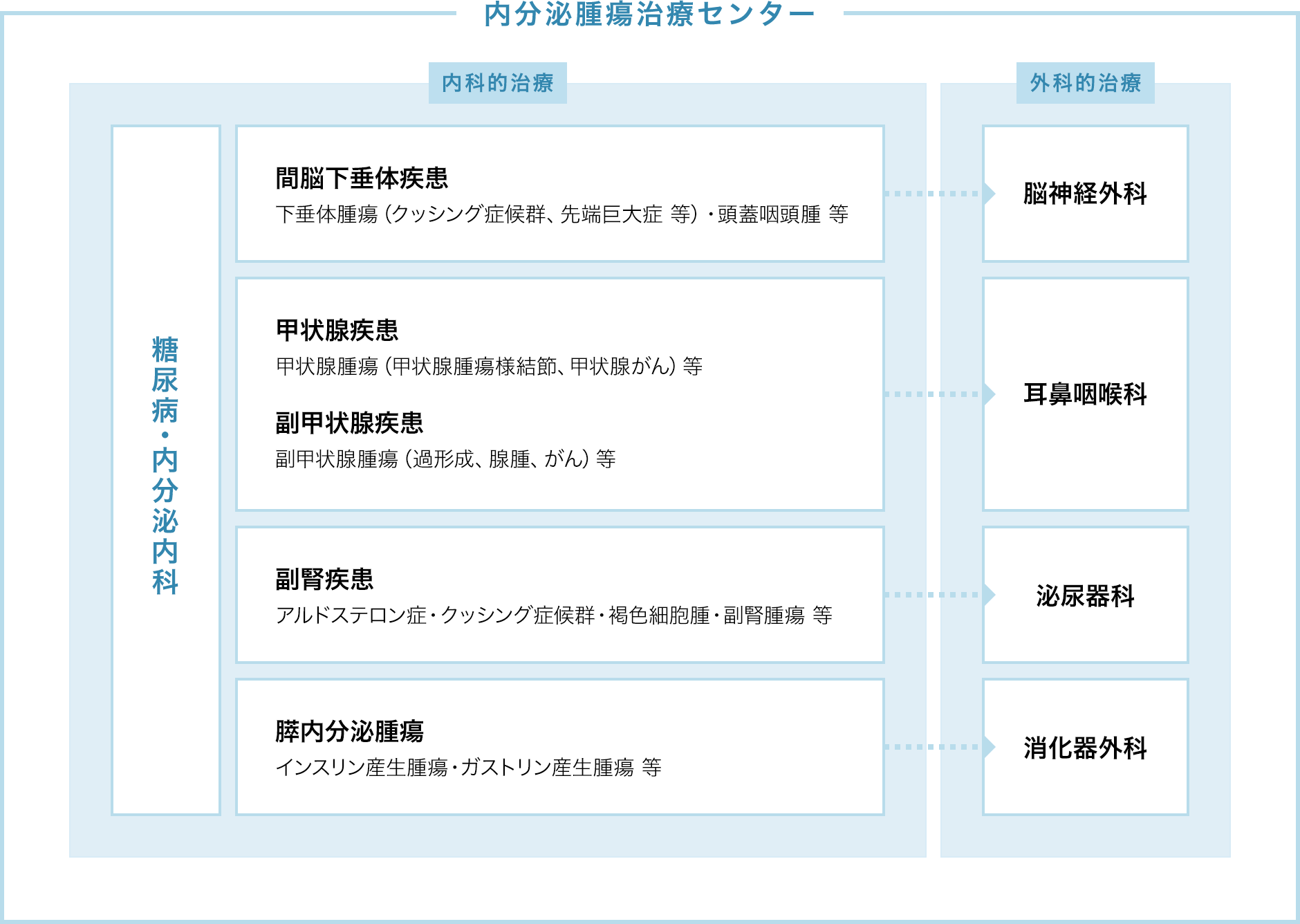
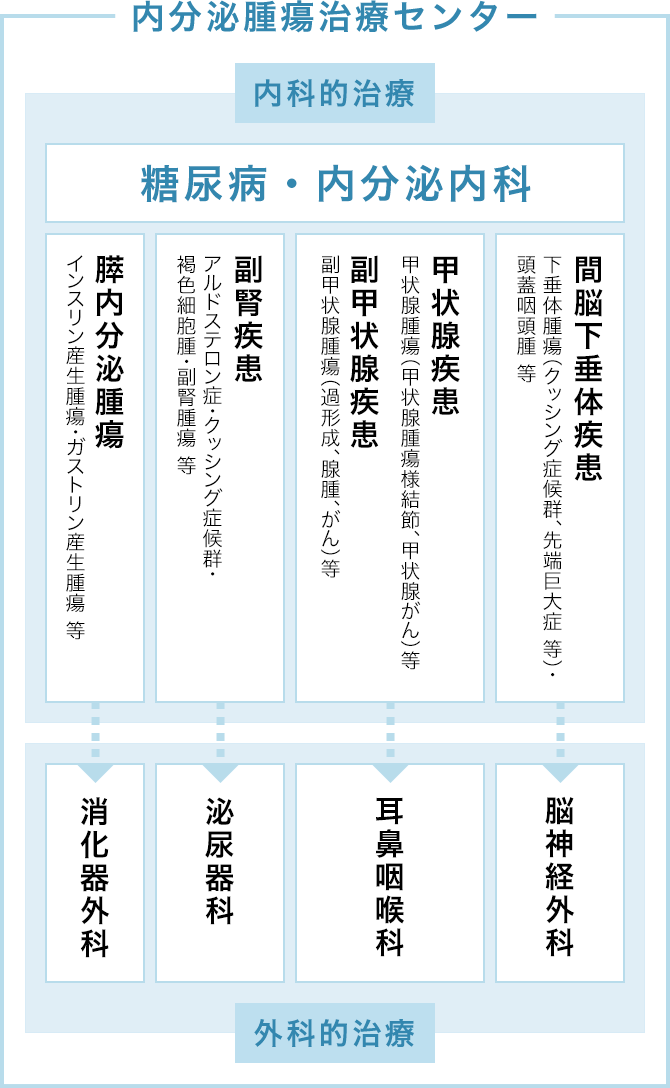
設立の背景・目的
全国における内分泌腫瘍疾患患者数(甲状腺悪性腫瘍、甲状腺の良性結節、副腎腫瘍、下垂体腫瘍の合計)は、2018年度に22,000人を超え、2016年度と比較して1割増加しています※1。また当院における患者数も、同期間で比較し2割増加と、全国の増加率を上回って需要が高まっております※2。
その一方、腫瘍を発見しても、脳外科、耳鼻咽喉科、消化器外科(内科)、泌尿器科、産婦人科など当該する診療科は異なり、紹介先の施設により担当する科が異なるなど、シームレスに手術および術後管理を行える施設が少ないことが課題として挙がっていました。
こうした背景を踏まえ、内分泌学会専門医による診断から専門的治療、また手術適応患者さんに対する外科系診療科とのシームレスな連携を推し進めることで、個々人に最適な医療を提供する体制を整えるため、『内分泌腫瘍治療センター』を立ち上げる運びとなりました。
- 2016年度~2018年度DPC公開データより
- 当院調べ
ごあいさつ
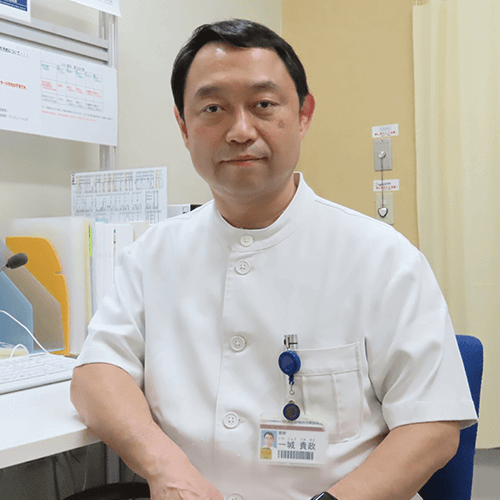
内分泌腫瘍は間脳・下垂体、甲状腺・副甲状腺、膵・消化管(神経内分泌腫瘍)、副腎、性腺と多岐に亘る臓器の腫瘍が含まれ、近年画像診断技術の進歩と画像検査施行頻度の増加により、その発見・診断数が激増しています。これらの腫瘍を発見したとしても、脳外科、耳鼻咽喉科、消化器外科(内科)、泌尿器科、産婦人科など当該する診療科は異なり、紹介先の施設により担当する科が異なることが課題とされていました。
さらに、内分泌専門医、甲状腺専門医が所属し、内分泌学的管理の下、必要時にシームレスに手術および術後管理を行える施設が少ないのが現状です。
こうした背景の中、性腺を除く上記腫瘍の内分泌学的評価および手術適応を一元的に担当することにより、より的確で迅速な診断・治療を提供することを目的に、この度『内分泌腫瘍治療センター』を設立させていただきました。
 疾患解説
疾患解説
内分泌腫瘍治療センターで対応している疾患について解説します。
下垂体腫瘍
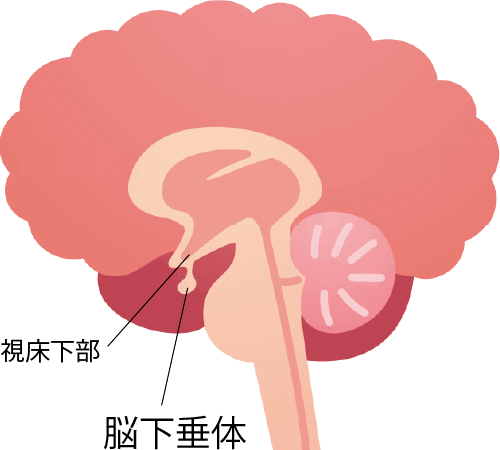
下垂体は、脳底正中部のトルコ鞍と呼ばれる骨のくぼみの中に存在しています。大きさ7~8mm、重さ約700mgの非常に小さな脳組織で、人体の各臓器に働きかける様々なホルモンを産生します。
前葉と後葉に分かれており、主に以下のホルモンが分泌されます。
- 前葉
- 副腎皮質刺激ホルモン(ACTH)、甲状腺刺激ホルモン(TSH)、成長ホルモン(GH)、乳汁分泌ホルモン(プロラクチン; PRL)、性腺刺激ホルモン(LHおよびFSH)
- 後葉
- 抗利尿ホルモン(ADH/バゾプレシン(AVP))
下垂体に生じる代表的な疾患として下垂体腫瘍(腺腫)があります。主に前葉の腫瘍からのホルモン過剰産生(ホルモン産生性下垂体腺腫)により発生し、様々な病気をもたらします。その代表的な疾患を下記に示します。
先端巨大症(成長ホルモン産生腫瘍)
成長ホルモン(GH)は下垂体前葉から産生されるホルモンです。小児期には、骨・軟骨・筋肉・臓器などの成長・増大に、成人においてもコレステロール代謝、筋肉・脂肪バランス、精神活動などに必要なホルモンです。
先端巨大症(成長ホルモン産生腫瘍)は、成長ホルモンの影響で様々な組織の過剰発育がもたらされ、手足が肥大したり、顔つきが変化したりする疾患です。思春期の骨端線閉鎖前に発症すると下垂体性巨人症、閉鎖後であれば末端肥大症となります。
前額部や下顎の突出、鼻翼・口唇・舌の肥大といった特徴的な顔貌、手足の増大に伴う指輪や靴のサイズ増大、いびき、発汗過多といった症状の他にも、糖尿病、高血圧症など生活習慣病の原因となることがあり、「靴や指輪が合わなくなった」、「糖尿病や高血圧症が発症または悪化した」といったことで気づかれることが多い疾患です。成長ホルモン過剰により悪性腫瘍の発症も多くなります。
治療の第一選択は手術ですが、腫瘍が大きすぎる場合や、周囲への浸潤の程度により手術のみで摘出できなかった場合、手術が困難な場合には、注射製剤や内服薬による内科的治療や放射線療法も組み合わせることで、成長ホルモンを正常域に保つようコントロールします。
クッシング病(ACTH産生腫瘍)
副腎皮質ホルモンであるコルチゾールは下垂体前葉からの副腎皮質刺激ホルモン(ACTH)の刺激により産生・コントロールされているホルモンで、生命活動維持のために最も必要なホルモンの一つです。全身の組織に作用して、糖・脂質・蛋白質・骨代謝や免疫機能をコントロールしています。
クッシング病はACTHの持続的過剰産生が原因で、血液中のコルチゾールが高い状態が続き、満月様顔貌、水牛様肩、中心性肥満、赤色皮膚線条、多毛といったクッシング徴候を生じるとともに、糖尿病、高血圧症、脂質異常症、骨粗鬆症といった生活習慣病を発症させたり悪化させたりする疾患です。コントロール不良の高血圧症、糖尿病、脂質異常症、骨粗鬆症で発見されることも多く、治療により生活習慣病が完治することもあります。
治療の第一選択は手術ですが、腫瘍が小さく発見に難渋することも多いため、手術により治癒が得られなかった場合や手術が困難な場合には、注射製剤や内服薬による内科的治療や放射線療法も組み合わせることで、コルチゾールを正常域に保つようにコントロールします。
プロラクチン産生腫瘍
下垂体前葉から分泌されるプロラクチン(PRL)は産後の乳汁分泌に必要なホルモンです。下垂体腫瘍のうちプロラクチンというホルモンを過剰に産生する腫瘍のことプロラクチン産生腫瘍と言います。
プロラクチンが過剰になると、女性のみではなく男性でも乳汁分泌が出現することがあり、女性では月経不順や不妊の原因となったり、男性では性腺機能低下などの症状を来したりするため、不妊治療中に発見されることも多い疾患です。腫瘍は比較的大きいことが多いものの、多くの場合は内服薬による内科的治療によりプロラクチンを正常域にコントロールすることが可能で、内科的治療のみで腫瘍の縮小効果が見られることもしばしばです。頭痛や視野欠損などの症状を伴う場合は手術適応となることがあります。
偶発的下垂体腫瘍(インシデンタローマ)
偶発的下垂体腫瘍(インシデンタローマ)は、「慢性頭痛、めまい、頭部外傷、健診などの下垂体腫瘍による症候(視野異常、下垂体機能低下症など) 以外の理由で施行された画像検査(CT、MRI など)で偶然に発見された下垂体部腫瘍あるいは腫瘤性病変」と定義されています。
上記に挙げたようなホルモンの過剰産生が認められない下垂体腫瘍は、非機能性下垂体腫瘍(腺腫)と呼ばれています。非機能性下垂体腫瘍は良性の腫瘍のため、症状がなければ経過観察とすることが多いですが、腫瘍が大きい場合は周囲への圧迫症状として頭痛、視野欠損といった症状や、下垂体ホルモン分泌低下(下垂体機能低下症)により、各ホルモンの欠落症状を伴います。
圧迫症状がある場合には手術適応となることがあります。また、圧迫症状がなくても下垂体ホルモンの分泌低下が見られる場合、特にACTH(副腎皮質刺激ホルモン)やTSH(甲状腺刺激ホルモン)の分泌不全による続発性副腎皮質機能低下症や下垂体性甲状腺機能低下症が見られる場合には、定期的な経過観察の必要性が示されています。これらを放置すると、手術や感染症などの人体に多大なストレスが加わった際に、複数の臓器が機能不全に陥る副腎クリーゼや甲状腺クリーゼを発症する可能性があり、命に関わる事態にもなりえます。
甲状腺腫瘍(結節)
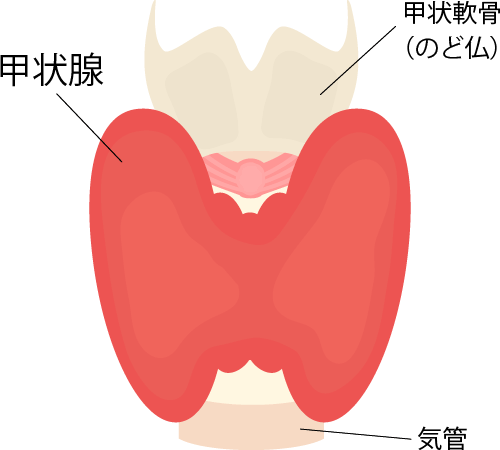
甲状腺は、前頚部の甲状軟骨(喉仏)と両側の胸鎖乳突筋の間に存在しています。重さ16~20g、大きさ4.5×4cm程度の臓器で、正面から見ると蝶のような形をしており、生命活動に不可欠な甲状腺ホルモンを産生しています。甲状腺腫瘍には、良性と悪性があります。
- 良性
- 濾胞腺腫、腺腫様甲状腺腫、嚢胞など
- 悪性
- 乳頭がん、濾胞がん、髄様がん、低分化がん、未分化がん、その他(悪性リンパ腫など)
甲状腺結節全体で最も頻度が高い腺腫様甲状腺腫は、多くの場合、経過観察のみで特段の治療は不要であることがほとんどです。一方、悪性腫瘍(甲状腺がん)の中でも全体の9割以上を占める乳頭がんは比較的予後良好ですが、予後不良の未分化がんも1~2%存在します。
甲状腺に腫瘍がみつかった場合には、まずは超音波検査を行います。その後、精密検査として穿刺吸引細胞診を行って良悪性の鑑別を行いますが、一部の結節では穿刺吸引細胞診では診断が困難なため、術後にがんが診断されるものもあります。
良性腫瘍(結節):
腺腫様甲状腺腫、甲状腺嚢胞、濾胞腺腫
健診や自己触診または頚動脈などの超音波により甲状腺に結節を触知・指摘されることで発見されることが多い結節です。良性結節には、腺腫様甲状腺腫や、甲状腺嚢胞、濾胞腺腫が含まれます。
良性の結節であれば、そのまま放置してもさほど生活に支障はありませんが、結節が大きい場合は手術により取り除くことが可能です。また、一部にホルモン産生性や悪性の疑いが否定できないことがあるため、その場合は精査の上、手術適応となることもあります。
甲状腺がん(乳頭がん、濾胞がん、髄様がん、未分化がん)
健診や自己触診または頚動脈などの超音波により甲状腺に結節を触知・指摘されることで発見されるものの中で、一部悪性と診断される結節があり、それを甲状腺がんと呼びます。甲状腺がんの治療の第一選択は手術です。
しかし、既に多発性転移が認められた場合や、甲状腺未分化がんでは手術適応とならないこともあり、抗がん剤やアイソトープ治療が選択されることもあります。
治療実績
| 2016年度 | 2017年度 | 2018年度 | 2019年度 | |
|---|---|---|---|---|
| 甲状腺腫瘍 手術あり | 29 | 33 | 35 | 39 |
| 年度 | 甲状腺腫瘍 手術あり |
|---|---|
| 2016年度 | 29 |
| 2017年度 | 33 |
| 2018年度 | 35 |
| 2019年度 | 39 |
副甲状腺腫瘍
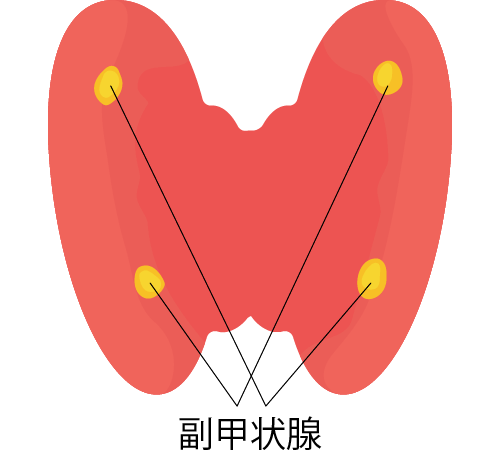
副甲状腺は、甲状腺の裏側にある米粒大の副甲状腺ホルモン(PTH)を分泌する臓器で、上下左右に合計4腺存在します。PTHは、体のカルシウムのバランスを整えるホルモンで、骨や腎臓に作用し、血中カルシウムをプラスバランスにする働きをします。
原発性副甲状腺機能亢進症(腺腫、過形成、がん)
原発性副甲状腺機能亢進症は、副甲状腺にできた腺腫、過形成、がんにより副甲状腺が腫大して副甲状腺ホルモンが過剰産生されることで、高カルシウム血症、低リン血症を引き起こす疾患です。
8割以上が良性の腺腫で、多くの場合、無症候性高カルシウム血症として発見されますが、多飲・多尿、腎結石、尿管結石、腎機能障害により発見されることもあり、高カルシウム血症の程度により、傾眠・昏睡や、筋力低下なといった神経・筋症状、悪心・嘔吐、消化性潰瘍、膵炎などの消化器症状、心電図変化や不整脈といった循環器症状など多彩な症状が出現し、長期間放置することにより難治性の骨粗鬆症を発症することもあります。
治療は第一選択として腫大した病的副甲状腺の手術があげられますが、手術が困難な場合には、内服薬での内科的治療を行います。
二次性副甲状腺機能亢進症(透析療法中など)
副甲状腺ホルモンは、血中のカルシウムを調節する最も重要なホルモンで、透析など他の原因で低カルシウム血症になった場合には、それを是正しようとするために応答性に副甲状腺ホルモンの分泌亢進が起こります。このように、副甲状腺そのものではなく、副甲状腺以外に病気の原因があり、その結果、二次的に副甲状腺ホルモンが増えて骨からカルシウムが失われる病態を二次性副甲状腺機能亢進症と呼びます。
治療の原則は原因の除去ですが、慢性腎不全に伴う透析療法中などでは原因除去は不可能であり、骨粗鬆症の重症化や異所性石灰化予防の観点からも手術適応となる場合があります。
副腎腫瘍
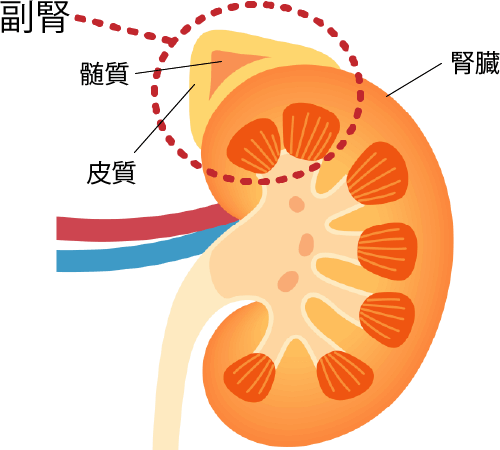
副腎は、両側腎臓の上腹側に存在する5~8g程度の臓器で、表層部の皮質と中心部の髄質に分かれています。皮質と髄質からはそれぞれ以下のホルモンが生産されます。
- 皮質
- 副腎皮質ホルモン(コルチゾール、アルドステロン、アンドロゲン)
- 髄質
- カテコラミン(アドレナリン、ノルアドレナリン、ドーパミン)
これら副腎ホルモンのほとんどは生命活動に不可欠なホルモンです。不足すると副腎不全で致命的な病状になることがある一方で、過剰に生産されると様々な疾患の原因にもなります。
副腎腫瘍の半数以上がホルモン過剰産生のない良性の副腎腺腫ですが、1/3はホルモンの過剰産生が認められ、様々な症状を発症し手術適応となります。また、副腎がんは極めて稀ですが、予後不良とされる病気であり、的確な診断と早期治療が求められます。
副腎偶発腫
副腎偶発腫は、副腎関連疾患を想定せずに施行した画像検査で偶然発見された副腎腫瘍で、全腹部CTのうち3%程度の確率で発見されます。そのうち、ホルモン過剰産生が認められない非機能性腺腫が半数以上を占めており、腫瘍の大きさが4cm未満であれば定期的な画像検査とホルモン検査を行い、腫瘍の増大傾向の有無およびホルモン過剰産生の出現の有無を確認し、経過観察します。
本邦においては未だ明確な診療基準が制定されておらず、当センターも診療基準策定委員の職員を中心に的確な診療を行っていきます。
機能性副腎腺腫(原発性アルドステロン症・クッシング症候群)
機能性副腎腺腫は、原発性アルドステロン症およびクッシング症候群が主な腫瘍です。
原発性アルドステロン症は、アルドステロンというホルモンが過剰に分泌されることで高血圧が引き起こされる疾患です。副腎皮質にできた腫瘍からのアルドステロンが過剰に産生されることにより、高血圧症や低カリウム血症を引き起こし、糖尿病の発症・悪化にも関与することが知られています。原発性アルドステロン症は、しばしば難治性高血圧症となることがあり、全高血圧の1割弱を占めています。そのうちの一部は手術適応です。
一般的な降圧薬での血圧コントロールのみでは、脳卒中、狭心症、心筋梗塞、不整脈の発症頻度が有意に上昇することが報告されています。特に、低カリウム血症、若年者、160/100mmHg以上、治療抵抗性高血圧、副腎偶発腫合併、40歳以下での脳血管障害発症、耐糖能障害、肥満、睡眠時無呼吸症候群などに該当する方は高リスク群とされており、積極的な検査が必要です。手術適応となり、手術をした場合、高血圧症が完治する場合もあります。高血圧症の方は一度は検査が必要です。
クッシング症候群は、副腎皮質ホルモンであるコルチゾールが副腎腫瘍により過剰産生されることで発症した病態です。コルチゾールは生命活動維持のために最も必要なホルモンの一つで、全身の組織に作用して、糖・脂質・蛋白質・骨代謝や免疫機能をコントロールしています。しかしその過剰産生により、満月様顔貌、水牛様肩、中心性肥満、赤色皮膚線条、多毛といったクッシング徴候を生じるとともに、糖尿病、高血圧症、脂質異常症、骨粗鬆症といった生活習慣病を発症させたり悪化させたりもします。コントロール不良の高血圧症、糖尿病、脂質異常症、骨粗鬆症で発見されることも多く、治療により生活習慣病が完治することもあります。治療の第一選択は手術で、内視鏡による手術が一般ですが、手術が困難な場合には内服薬での内科的治療でコルチゾールのコントロールを図る場合もあります。
副腎がん
副腎がんは、全副腎腫瘍における割合は1.4%と稀な腫瘍ですが予後不良の疾患です。しばしばクッシング症候群として発見されたり、副腎偶発腫として発見されたりします。
一般には巨大な副腎腫瘍として発見されることが多く、発見時には既に多発転移を来していることもあります。術前に転移がなかったとしても、術後に転移が見つかることも少なくなく、術後の抗がん剤治療も必要となります。
また、発見時に非機能性副腎腺腫と診断されても、その後の経過観察の間に副腎がんと診断が変わることもあり、厳重な経過観察が必要なため、副腎疾患に精通した専門医での診療が望ましいです。
褐色細胞腫
褐色細胞腫は、副腎髄質やその周囲の神経節に発生する腫瘍で、カテコラミンの過剰産生により、高血圧、動機、頻脈、胸痛、頭痛、顔面蒼白、発汗、不安感、高血糖など多彩な臨床症状が現れます。
全高血圧患者に占める褐色細胞腫の割合は0.1~0.6%と比較的稀な疾患で、褐色細胞腫患者の内、約65%の方が高血圧と診断されています。また、褐色細胞腫には、血圧の変動の激しい発作型、持続的に高血圧を呈する持続型、両者の組み合わせからなる混合型の3分類があります。それぞれ約1/3ずつの頻度で発生しますが、35%は症状が見られない無症候性です。
近年、副腎偶発腫として発見されることも多くなってきており、副腎偶発腫のうち8.5%が褐色細胞腫であったと報告されています。また、副腎外、両側性、悪性は各々約10%で、最大60%に遺伝子異常が認められ、少なくとも18種類の関連遺伝子変異が報告されています。経過中に、前屈姿勢、運動、くしゃみ、排尿・排便、腹部診察、ヨード造影剤検査、一部薬剤など様々な誘因により高血圧緊急症を発症することがあり、著明な高血圧、心血管系合併症を発症し予後不良となります。
治療の第一選択は手術で、一般的には術後良好な経過をたどることが多いものの、稀に診断時に既に多発転移が認められることもあります。その際には抗がん剤による化学療法や放射線療法の適応となります。
褐色細胞腫は、近年、WHOにおいて転移の可能性がある潜在性悪性腫瘍と位置づけられ、術後も生涯に亘り経過観察が必要とされています。
治療実績
| 2016年度 | 2017年度 | 2018年度 | 2019年度 | |
|---|---|---|---|---|
| 副腎腫瘍 手術あり | 14 | 8 | 6 | 23 |
| 年度 | 副腎腫瘍手術あり |
|---|---|
| 2016年度 | 14 |
| 2017年度 | 8 |
| 2018年度 | 6 |
| 2019年度 | 23 |
膵・消化管神経内分泌腫瘍
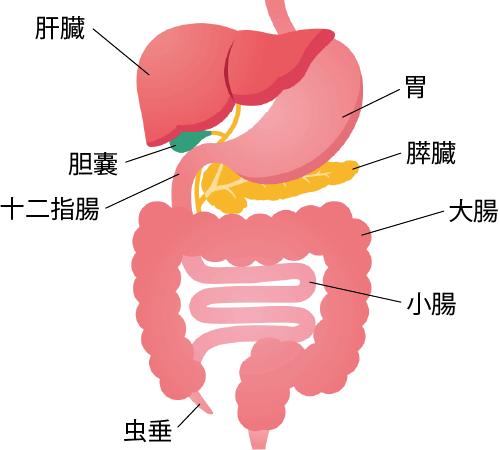
消化器に発生する神経内分泌腫瘍(NEN)は、年間10万人あたり3~5人に発症する比較的稀な疾患で、その多くは膵臓と消化管に発生します。
一部の膵・消化管神経内分泌腫瘍はホルモン過剰による症状により発見されることがあり、機能性(ホルモン産生性)です。一方、非機能性腫瘍は健診や腹部症状の精査中に腹部超音波やCTまたは上・下部消化管内視鏡検査によって、偶然発見されることが多くなっています。
当センターでは、内分泌腫瘍治療センターとして機能性(ホルモン過剰分泌)膵・神経内分泌腫瘍を腫瘍制御の観点で診療を行うとともに、ホルモン過剰症状のコントロールを行います。
インスリノーマ(インスリン産生腫瘍)
インスリノーマは、インスリンを分泌する膵臓にできる腫瘍です。インスリンが過剰分泌されることによる低血糖発作を繰り返すことで発見されます。
主な症状としては空腹時低血糖や発作が多いものの、食後低血糖のこともあります。自律神経症状として発汗、空腹感、震え、嘔気、動悸など、中枢神経症状として複視、昏迷、異常行動、健忘などの症状が認められます。また、重症低血糖になると意識障害、昏睡に至ることも多く、長時間の放置により不可逆的脳障害(低血糖脳症)を発症します。
治療の第一選択は手術ですが、腫瘍の発見に難渋することも多いため、手術困難な場合は内服薬や注射療法を併用しながらインスリン分泌のコントロールを図ります。
ガストリノーマ(ガストリン産生腫瘍)
ガストリノーマは、膵臓または十二指腸壁に発生するガストリン産生腫瘍で、神経内分泌腫瘍からのガストリン過剰産生に伴う胃酸分泌過剰による消化性潰瘍として発見され、十二指腸球部を中心に十二指腸、空腸に高い頻度で発生します。潰瘍は難治性、易再発性、多発性を特徴とし、ゾリンジャー・エリソン症候群と呼ばれます。
治療の第一選択は手術ですが、腫瘍の発見に難渋することも多いため、手術困難な場合は内服薬や注射療法を併用しながらガストリン分泌のコントロールを図ります。
 スタッフ紹介
スタッフ紹介
一城 貴政いちじょう たかまさ
- 糖尿病・内分泌センター長
- 糖尿病・内分泌内科部長
専門分野
内分泌・糖尿病、原発性アルドステロン症、二次性高血圧症、副腎疾患
学会専門医・認定医
- 日本内科学会認定医・総合内科専門医・指導医
- 日本内分泌学会内分泌代謝科専門医・指導医・評議員
- 日本糖尿病学会専門医・指導医
- 日本高血圧学会正会員・指導医
- 日本甲状腺学会専門医
- 日本ステロイドホルモン学会評議員
山下 馨やました かおる
- 糖尿病・内分泌内科医長

内分泌疾患を中心に、患者さんごとに最善の医療を提供できるよう心がけています。
専門分野
内分泌・糖尿病
学会専門医・認定医
- 日本内科学会認定医・総合内科専門医
- 日本糖尿病学会専門医・指導医
- 日本内分泌学会内分泌代謝科専門医・指導医
- 日本消化器内視鏡学会専門医
- ICLSProvider
- JATEC Provider
 診療表/診療予約
診療表/診療予約
内分泌腫瘍治療センターの診療表、診療予約についてご案内いたします。
受診方法
ご希望の予約日・予約枠を選択の上、
紹介状をお持ちの患者さん、もしくは紹介状を作成された医療機関より下記までお電話ください。
オンライン予約も可能です。
045-576-3000(代) (受付時間 9:00~16:00 土日祝休)
オンライン予約はこちら- 「内分泌腫瘍治療センターの初診予約」であることをお申し出下さい。
当日のお手続き
保険証・紹介状をご持参の上、予約時間の15分前に1階12番の受付窓口までお越しください。
12番受付に「内分泌腫瘍治療センターの初診」である旨をお声かけください。
- 予約時間に遅れた場合には、お待たせする事もございます。ご了承ください。
- 紹介状の事前郵送は不要です。


内分泌腫瘍関連のご相談を何でも受け付けています。